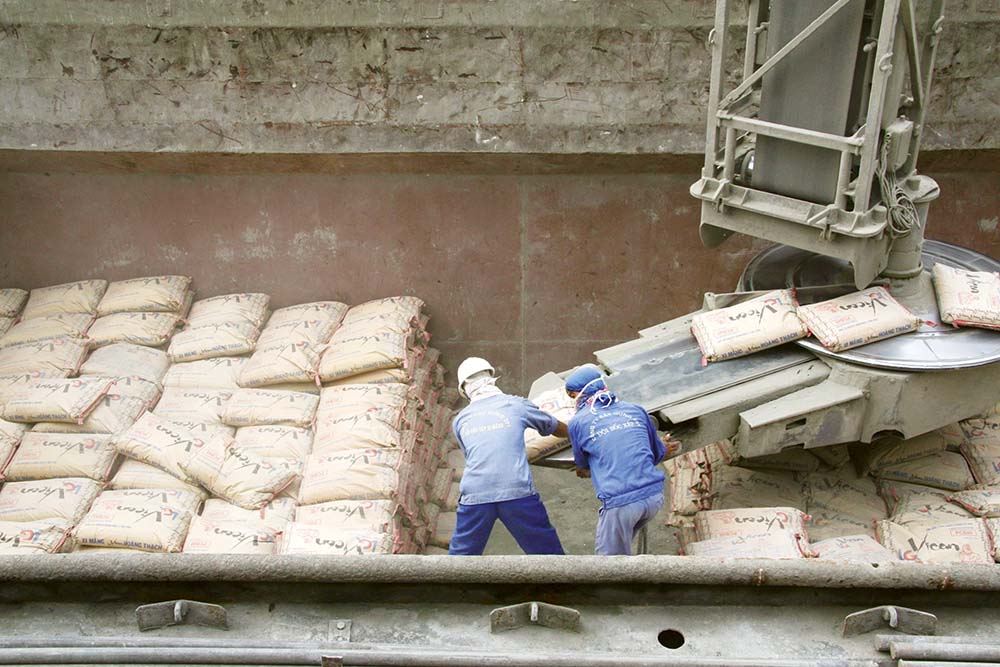The real estate market is sluggish, causing cement to be sluggish. The cement industry has had to cut capacity, many "big guys" have stopped production, and revenue has plummeted.
 |
| Losses have forced many cement production lines to operate at a standstill or even stop production. |
Up to 42 production lines stopped
“Never before has the cement industry been in such a dire situation. In 2023 alone, the number of production lines that had to stop production for 1-6 months reached 42, of which some lines had to stop for the whole year,” a representative of the Vietnam Cement Association (VNCA) exclaimed when reporting on the industry’s production and business situation.
In the period 2014-2022, the annual output of clinker and cement consumption increased sharply, typically in 2022, the whole industry consumed 108.4 million tons. However, in 2023, consumption decreased seriously, reaching 87.8 million tons, equal to 88% of 2022. In the first 6 months of 2024, the situation was similar to last year.
Also from 2023 to present, clinker and cement production has seriously decreased, with total output in 2023 reaching only 92.9 million tons, and the entire industry's operating lines only reaching 75% of their design capacity.
Even large enterprises have to stop their kilns because they cannot sell their products, such as Phuc Son Cement, Cong Thanh, Duyen Ha, and Luckcemen, which will stop both production lines for the whole year of 2023; Thanh Thang Cement and Vissai Ha Nam will stop one production line for the whole year.
The first half of 2024 is not much better. Total production output in the first 6 months of the year is estimated at 44 million tons, equivalent to the same period last year. Factories are only running at 70-75% of their total design capacity, with accumulated inventories currently at 5 million tons.
The cement consumer market is gloomy, while the total designed capacity of the cement industry is too large (123 million tons, but can produce tens of millions of tons more than this number), so there are currently 4 production lines with a capacity of 11.4 million tons of cement/year, which have been completed but have not been put into operation because the products cannot be consumed.
According to the Ministry of Construction, the total financial investment in building cement factories is estimated at current value at VND500,000 billion (equivalent to USD20 billion), of which financial sources from domestic banks and state capital account for about 75% of the total investment.
How to remove?
Cement production and consumption are plummeting, and finance is a big problem for businesses in this industry.
Due to slow consumption, many businesses have had to stop some production lines, leading to difficulties in cash flow to repay credit institutions and input costs of raw materials and fuel. Many cement factories produce inefficiently, leading to losses and bad debts.
In 2023, Vietnam Cement Corporation (Vicem) reported a pre-tax loss of VND500 billion for the first time. In the first quarter of 2024, Vicem Ha Tien's revenue decreased by nearly 12% compared to the same period last year, down to VND1,495 billion due to a decrease in cement consumption in the quarter. The company lost nearly VND25 billion after tax.
Similarly, Bim Son Cement recorded net revenue in the first quarter of 2024 of VND 690 billion, down 18.6% compared to the same period in 2023 and a loss after tax of nearly VND 50 billion, while in the same period last year it lost VND 48.6 billion. This is the 7th consecutive quarter of loss for this enterprise since the third quarter of 2022.
Vicem But Son Cement (code BTS) also lost more than 55 billion VND, marking the 6th consecutive quarter of losses.
The list of cement businesses reporting losses continues to grow.
At the conference on removing difficulties and promoting production and consumption of cement, steel and construction materials chaired by the Prime Minister last weekend, Deputy Minister of Construction Nguyen Van Sinh said that many cement factories are currently under great financial pressure and difficulties due to large initial investment loans, high production costs, and slow product consumption, making cash flow in production uncertain.
Representatives of the Ministry of Construction proposed that the Prime Minister and the State Bank adjust policies on debt forgiveness, debt extension, and lowering bank interest rates for debts of construction material and cement enterprises to suit their current capacity to fulfill financial obligations.
At the same time, it is recommended that the Prime Minister and the Ministry of Finance adjust tax policies to ensure competitiveness with other exporting countries, specifically adjusting the export tax on cement clinker, currently at 10%, to 0%, because this is a deeply processed product.
Along with that, amend the Law on Value Added Tax in the direction that clinker products are not subject to Clause 2, Article 5; so that clinker is subject to a 10% value added tax rate when exported as for domestic consumption and is deducted from input value added tax similar to cement products.
On the other hand, Mr. Nguyen Quang Cung, Chairman of VNCA, said that to overcome difficulties in cement production, it is necessary to encourage the use of cement to build highways and viaducts in areas with weak terrain such as the Mekong Delta, some areas in the Central region and mountainous areas.
Promote the use of cement to reinforce the roadbed instead of the current traditional technology of filling the highway bed with soil and sand to increase the life of the project.
The government directed banks to extend debt and reduce interest rates for cement enterprises, prioritize cement enterprises to borrow working capital, and discourage FDI investment in the cement industry because domestic enterprises have mastered the technology.
“If the difficult situation of cement enterprises continues, the transfer of ownership from domestic investors to foreign investors will take place, causing the risk of the cement industry falling into the hands of foreign enterprises, which in the long term will affect market regulation and price stabilization of this item,” the VNCA representative worried.
Source: https://baodautu.vn/noi-dai-danh-sach-cong-ty-xi-mang-bao-lo-d217945.html



































































































Comment (0)